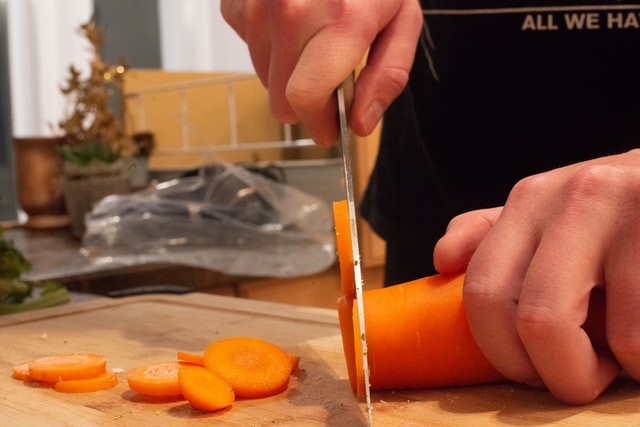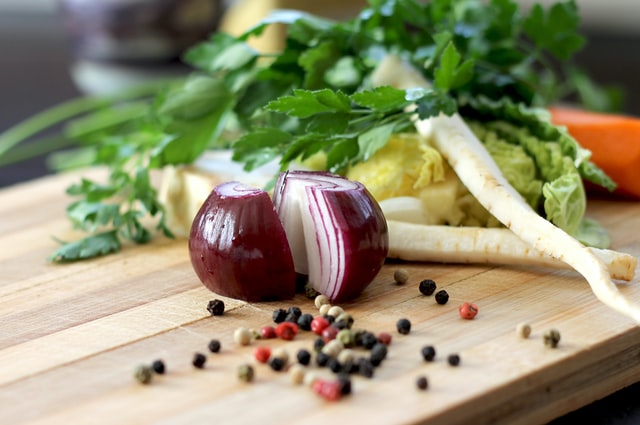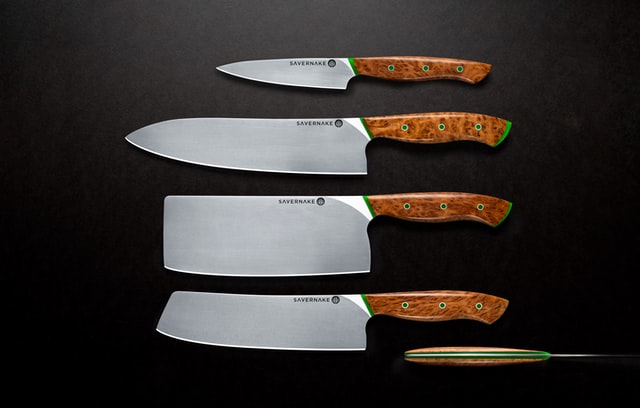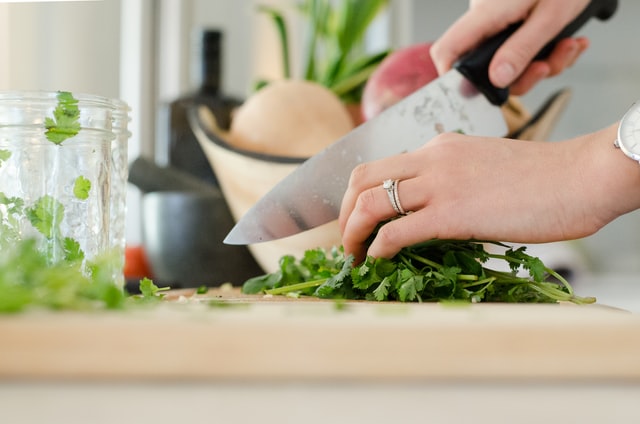Have you ever been amazed by chefs on television who hold the knife like a powerful magician? Or maybe you just want to make your visitors impressed with your cutting skills? Don’t worry much! The good news is you only be in need of basic knife skills to slice like a professional. Proper knife skills not only make cooking and food prep more manageable and safer but can give you a lot of confidence in the kitchen. Even professional chefs didn’t start being perfect with their knife skills. It is a long process, but if you are really determined to be one, you must have confidence and a happy heart.
To help you begin your self-training (aside from watching video tutorials), here are the techniques on how to make your hands comfortable in holding the knife. But before jumping to the method, you must know first how to choose the right knife.

USING THE RIGHT KNIFE
There are a ton of knives available in the market, and I’m sure you also have lots in your cabinet. Typically, a chef’s knife or French knife that is between 8 to 12 inches is the one used for practice and everyday cooking. Classic chef knives got a nice handle and thick blade that is also an absolute kitchen tool.
The classic Chef’s knife is the most useful knife in the kitchen and one that you will use for basic knife skills.
🔪 Preparation

Before starting to cut all of those ingredients, make sure that your cutting board is stable and not moving around while you chop. This is because an unstable chopping board can be so dangerous that you can cut yourself deep. Just put a damp cloth underneath the cutting board to secure it in place.
Next, make sure that the foods you are using are not rolling around on the cutting board or countertop. It might be easy to control small things such as herbs, but larger items like carrots, apples, or onions can make your cutting experience dangerous.
After your preparation, you are now ready to start picking your knife. Remember that when choosing a knife, you must consider the two essential parts: the blade and the weight.
🔪 Blade and Weight

It is essential to consider these two parts. This is because every person has different limits when holding a knife. For example, the knife they gave you is big and heavy, but you don’t have a firm grip; you might drop it and cause injury. So before buying a knife, check if you are comfortable enough to hold it for an extended period.
The blade is also essential because it will determine what type of cooking you are going to prepare. Depending on your goal, you must know when to use highly sharp blades to prevent kitchen accidents and injuries. So if you are planning to slice a piece of meat up to its bones, use a super sharp knife. But if you are going to cut fruits or vegetables, choose a blade that is sharp enough and not to the point that it will juice or mush your ingredients.
KNIFE BASIC RULES
Don’t get too excited about showing your knife skills. You must first be aware of the basic rules of preparation so that you can get the most out of it. Without further ado, let’s reveal the things you need to consider to be skillful in cutting.
🔪 Sharpen your knife
Always sharpen your knife before meal prep. This is because sharp blades cut quickly into the food, and this will prevent it from sliding off the surface.
🔪 Cutting board
To be skillful in cutting, you must also consider the type of cutting board. You can use plastic, wooden, or composite cutting boards. Other surfaces like glass, metal, or stone can make your knife blades dull.
🔪 Cleaning
The last basic rule is cleaning the knife by hand. Remember not to put quality knives in a dishwasher. You can just wipe the blade clean and air dries it. This will help maintain the sharpness of your blade.
After cleaning, if you noticed some stinky odor coming from your kitchen sink, click here for more information.
TYPES OF KNIFE
So you have already cleaned your kitchen counter, and you’re ready to cut. But what kind of knife will you need? There are various knives available in the market. It is normal to be confused about what brand you must choose or how big a knife is good for you. But, there is an uncomplicated way to determine this.
Surprisingly, there are three main knives that you can choose from. These knives are enough for you to finish your meal preparation. The knives I’m talking about are the Chef’s knife, paring, and serrated knife. So what are their differences, and when to use each of them?
🔪 Chef’s knife
Use a chef’s knife if your goal is for dicing and chopping ingredients. This is the most basic knife that you can get out of your drawing and is very easy to handle. There are lots of brands in the market and just choose where your hands are comfortable with.
🔪 Paring knife
This knife is for small jobs like seeding, peeling, and trimming the fat from meat. The paring knife is also safe because of its size, especially when you are peeling cloves of garlic.
🔪 Serrated knife
This is specifically used for slicing tomatoes and bread. With the presence of its teeth, it can slice like a saw to have that perfect cut for your loaf of bread.
HOLDING THE KNIFE
So to perfectly hold the knife, what you want to do is grab and pinch it by the blade using your thumb and pointer finger. That means the top of the blade will be pushing into the base of your pointer finger, where callous usually develops.
Aside from holding the knife, your other hand will also play a significant role, and that’s for holding your ingredient. Tuck your fingertips, and then simply rock the knife back and forth. You can practice on a carrot or any vegetable, even celery. Let the steel of the blade run on your knuckles. You can try ten carrots to make your hands comfortable in cutting.
CUTTING TECHNIQUES
There are two main cutting techniques that you must practice before making yourself a knife master. These are the cross chop and rock chop. These two techniques are the most common cutting style that you use in everyday cooking and food prep. So with practice and mastery, you can achieve your goal of being a knife expert.
🔪 Cross chop
The first cutting technique is cross chop. This type of cutting technique starts by using the pinch grip for holding the knife, and then the other hand is placed right on top of the knife, keeping the tip down. Then, you are going to rock back and forth. Remember that the use of the other hand is more of a guide, so you don’t want to apply any weight. This cross chop is usually done to herbs like parsley. You can start off slow and then add up the speed while chopping off your ingredients.
The advantage of cross chop is that it’s very safe. You are keeping your fingers out of the way by placing them on the tip of the knife.
🔪 Rock chop
The following cutting technique is the rock chop. So you are going to use the exact grip as the cross chop to hold the knife. Then make sure again to keep the tip of the knife down on the cutting board, and you are going to rock with the knife hand. Now, what will your other hand do?
Your other hand is for holding the ingredient. You are going to use fingertips to face the knife and then slowly curl them in. You will tuck the loose thumb underneath to avoid being cut and hiring yourself. To simplify, your other hand should resemble a claw, and with this grip, you can actually slowly push the ingredient into the cutting motion of the knife.
Just remember that as you lift the knife, it must rest up against your knuckles and never lifts higher so that you can avoid cutting yourself.
KNIFE SAFETY TIPS

So now you are getting fast on holding the knife. But keep in mind that regardless of how much experience you have, the blade can be dangerous when improperly used and cause serious injury to you and others around you. So follow the safety tips to get the most out of your knives while avoiding unnecessary trips to casualty.
🔪 Sharp is safe
Using a sharp knife is advised. Though it may look dangerous, a sharp knife is safer than the dull one. You can evaluate the sharpness by simply passing your finger on the edge perpendicularly on the edge of the knife. You will indeed feel the difference between a sharp and dull knife.
If you are using a dull knife, it may rip and may cut yourself instead of the ingredient. But if you use a sharp one, it just goes through, avoiding your fingers.
🔪 Type of knife
Use the appropriate size and type of knife specific for the job. For example, using a chef knife to peel a clove of garlic may be challenging because of its large size. Instead, you can use a smaller one like the paring knife, which is perfect for the peeling job.
🔪 Pressure
Hold the knife firmly and have a good grip. Remember not to hold the knife loosely, and when you hold it firmly, it should be the extension of your hand. Then, you can now slice vegetables easily and always cut away from yourself. That is why you must place the knife blade side away from yourself after using it. Because if you leave the blade facing you and you want to pick your ingredient, you may slice yourself accidentally.
🔪 Flat areas
Make sure to place your knives on clear and flat areas. It is very important always to lay your knife flat because this can prevent your knife from falling down your countertop and target your feet. Also, if you let your knife rest in an unstable manner, you might accidentally grab the blade instead of the handle.
Also, keep in mind to put your knives on a clear surface where they are very visible. Because if your knife is hidden by the rag, for example, you may inadvertently hurt yourself by grabbing it. Likewise, do not grab your knife without your 100% attention. This is to prevent grabbing the blade instead of the handle.
🔪 Pointing the knife
If there is a case where you need to pass the knife to another person, point the knife handle toward him. It will be safer to grab it in that way. Do not also walk around with your knife while the blade is pointing towards people. You can point the knife down to make it safe for you and the people everywhere. Also, keep your hand in front of you to cover the knife blade, especially if there are other people in the kitchen. Announce yourself that you’re holding a knife so that people will be aware of staying inches away from you.
🔪 Wearing glasses
Wearing glasses is totally fine. But there will be a time that you need to adjust your glasses on the nose, right? So usually, there are people who forget to put down their knives and adjust their glasses. That is very dangerous because either you can stab the person behind you or you can poke your eyes with the knife you are holding.
BOTTOM LINE
The only way you are going to get better with knife skills is by practicing cutting techniques. So make sure your cutting board and ingredients are stable. Also, keep in mind that your fingers, especially your thumb, are tucked away from the blade. By following these simple steps, you will indeed have a lot more confidence in the kitchen and make cooking a lot safer.
If you think of the knife as an extension of your hand, it can make shopping a lot easier and less dangerous. In fact, knowing how to hold a chef’s knife properly is key to safe and easy use. Many people are scared to pick up a knife because they have no idea how to use one. But, by developing your knife skills, you will improve the precision and speed of your cutting.
Hopefully, this guide will help you with your knife skills and impress your visitors while you’re cutting their favorite cheese in front of them. Just remember that the more comfortable you are with your knife, the better you’ll be able to maneuver it around objects and food.
